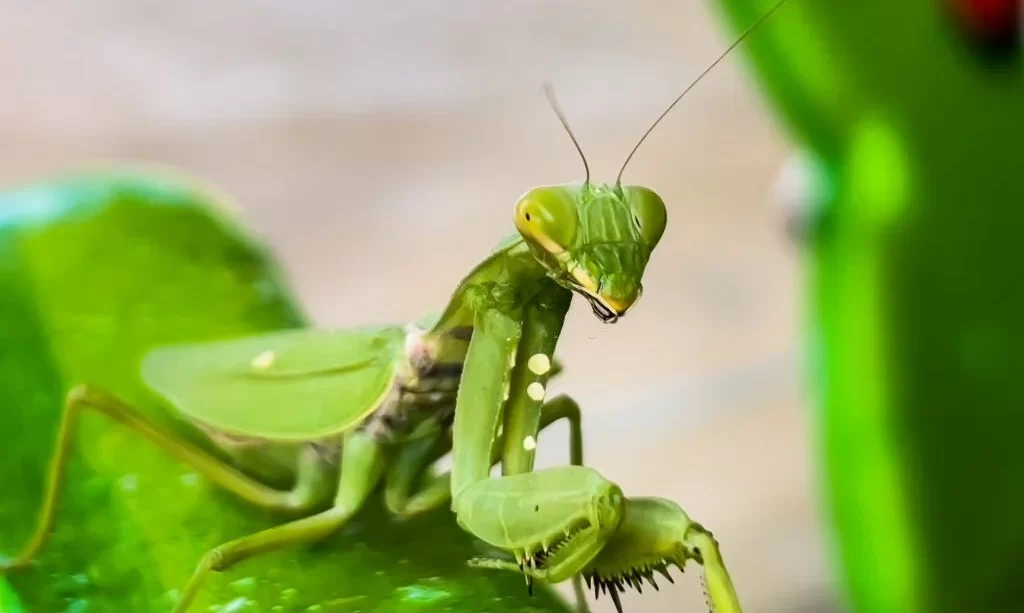The presence of a praying mantis in your garden or outdoor space is not just a delightful addition; it’s also a boon for your ecosystem. Praying mantises are nature’s pest controllers, renowned for their voracious appetite for garden nuisances like aphids, flies, and caterpillars. These remarkable insects are not only fascinating to observe but also serve as a natural form of pest control, reducing the need for chemical treatments. If you’re eager to welcome these helpful predators to your garden, you’ve come to the right place. This article is your guide to attracting praying mantises. We’ll start by exploring how to create a praying mantis-friendly habitat, then discuss the importance of avoiding harmful chemicals and pesticides to ensure their well-being.
Create a Praying Mantis-Friendly Habitat
To invite praying mantises into your garden, the first step is to design an environment that suits their needs. Praying mantises thrive in open spaces with diverse vegetation. They require perching spots to lie in wait for their prey, so incorporate structures like tall grasses, shrubs, or even small trees that provide shelter and vantage points. Mantises are stealthy hunters and love to surprise their prey, so having hiding spots is essential. Native plants are also a great addition to your garden, as they can attract a variety of insects, which, in turn, become prey for the mantises. A well-balanced garden that offers a variety of microhabitats will not only support mantises but also contribute to the overall health of your garden ecosystem.
Avoid Harmful Chemicals and Pesticides
One of the most crucial steps in creating a mantis-friendly environment is to avoid using harmful chemicals and pesticides in your garden. Praying mantises are sensitive to these chemicals, and exposure can be detrimental to their survival. Pesticides designed to eliminate common garden pests can also harm beneficial insects like mantises, inadvertently disrupting the natural balance of your garden ecosystem. To ensure the well-being of mantises and other beneficial insects, adopt organic and sustainable gardening practices. These methods not only promote a healthy environment but also encourage the presence of these remarkable predators in your garden. Remember, a thriving garden is one that welcomes the full array of creatures that contribute to its vitality, and praying mantises are an important part of this ecological puzzle.
Garden Maintenance and Cleanliness
Maintaining a well-kept garden is a fundamental aspect of attracting and sustaining a praying mantis population. Praying mantises thrive in environments with abundant prey, and a tidy garden with proper maintenance can facilitate this. Regular pruning, weeding, and clean-up not only keep your garden looking its best but also create an ecosystem that supports mantis populations. Dead plants and garden debris can provide hiding spots for pests and reduce the availability of prey. By keeping your garden clean and well-tended, you increase the likelihood of attracting the insects that mantises prey on. In essence, good garden hygiene promotes the presence of these beneficial predators, contributing to a thriving and balanced ecosystem.
Attract Prey Insects
To successfully attract and sustain a population of praying mantises in your garden, you need to ensure there is a ready supply of prey insects. This involves creating an environment that not only accommodates mantises but also the insects they hunt. Planting nectar-rich flowers is an effective strategy to draw in pollinators, such as bees and butterflies. These pollinators, in turn, attract a variety of smaller insects that serve as mantis prey. Consider incorporating plants like marigolds, lavender, or coneflowers, which are known for their ability to attract beneficial insects. By creating a diverse and insect-friendly garden, you’re essentially laying out a buffet that appeals to both mantises and their potential prey. This harmonious environment encourages a robust mantis population while supporting overall garden health through natural pest control.
Use Praying Mantis Egg Cases
Introducing praying mantises to your garden can be as straightforward as using praying mantis egg cases, also known as oothecae. These cases contain multiple mantis eggs and can be purchased from garden centers or online. Placing these egg cases strategically in your garden provides a controlled way to introduce mantises. When the time is right, young mantises will hatch from these cases and begin their life in your garden. Ensure you follow the instructions for placing and protecting the egg cases, as these cases are vulnerable to predators and weather conditions. Using mantis egg cases is an effective way to boost your local mantis population and enjoy their pest control benefits.
Provide a Water Source
Water is essential for all garden inhabitants, including praying mantises. While mantises primarily obtain moisture from the insects they consume, having a reliable water source can enhance their habitat. Shallow dishes filled with water or a small water feature can serve as watering stations for mantises. These also attract other insects, which indirectly benefits the mantises by offering a constant supply of prey. A consistent water source ensures that your mantis population remains healthy and can thrive in your garden.
Conclusion
Attracting praying mantises to your garden is not only a joy for nature enthusiasts but also a strategic move for garden health. Praying mantises are nature’s pest controllers, and by creating a mantis-friendly habitat, avoiding harmful chemicals, maintaining garden cleanliness, and attracting prey insects, you’re effectively fostering a balanced ecosystem that can naturally regulate garden pests. Using mantis egg cases and providing a water source are additional steps to ensure their presence.
As you watch mantises gracefully patrol your garden, consider it a testament to your efforts in promoting a more natural and sustainable approach to gardening. Your garden is not just a place of beauty but also a sanctuary for these beneficial predators. By welcoming mantises into your garden, you’re embracing a harmonious coexistence with the insect world, where natural balance and health are key. Enjoy the rewards of your mantis-friendly garden as it flourishes with thriving plants and a pest-free environment, all thanks to the enchanting presence of these remarkable insects.



